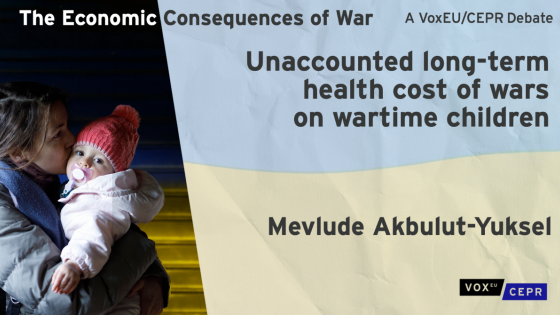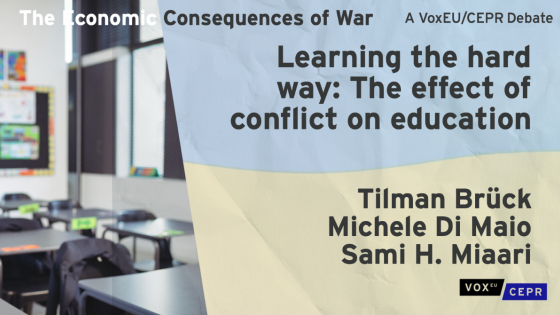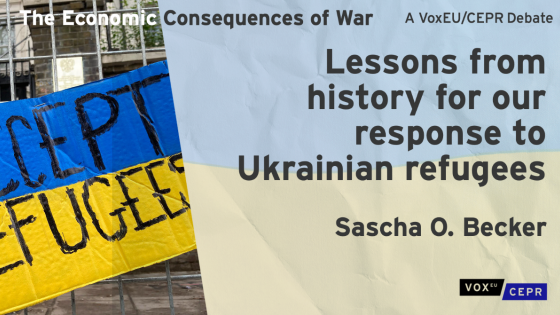There has been an increase in warfare and threats of interstate war in recent years. The number of countries engaged in armed conflict surged dramatically, reaching levels unprecedented since the end of the Cold War. A particularly disturbing manifestation of this development is the rise in the number of children living in territories or countries in armed conflict or emerging from war, raising concerns over the long-term psychological harm to children from the trauma of war and armed conflicts.
For instance, the current war in Ukraine triggered by Russia’s invasion of Ukrainian territories has led to millions of children abandoning their schools and leaving their homes to move into bomb shelters, underground metro stations and parking lots, and refugee facilities. The trauma, fear, and anguish Ukrainian children are experiencing likely place an enormous strain on their mental health, which may persist throughout their lives.
Beyond armed conflict and warfare, children also face a sharp increase in exposure to terrorism, gun violence, and mass public and school shootings as a common occurrence in their lives (Chrisman and Dougherty 2014, Kadir et al. 2018, Soni and Tekin 2020, 2022). While the incidences of wars, terrorism, and mass gun violence are on the rise worldwide, the global burden of mental health disorders has also been increasing, with a current cost of $2.5 trillion annually expected to reach $6 trillion by 2030 (de Menil and Glassman 2015, Mnookin 2016). Therefore, it is imperative to understand whether or not exposure to armed conflict has a toll on mental health and the extent to which this toll contributes to the global burden of mental illness.
Childhood experiences and long-term mental health
While there is a growing body of research on the relationship between early childhood experiences and the development of mental health ailments later in life, there are very few studies considering exposure to warfare as an adverse experience. One example is Singhal (2019), which shows that early-life exposure to bombing during the American War in Vietnam has had a deleterious effect on the mental health of the Vietnamese population in adulthood. Along similar lines, Kim and Lee (2014) document that exposure to the Korean War in late childhood to the early teenage years has had a long-run negative impact on mental health indicators, including depression, fear, insomnia, and loneliness. Bratti et al. (2015) find that trauma experienced during the war in Bosnia and Herzegovina between 1992 and 1995 significantly increased the likelihood of depression six years after the conflict. Finally, Kesternich et al. (2014) examine the long-run effects of WWII on the socioeconomic status and health of older individuals in 13 European countries and show that living in a war country during WWII is associated with a higher likelihood of expressing depressive symptoms at older ages.
In our recent paper (Akbulut-Yuksel et al. 2022), we examine the long-term mental health impact of childhood trauma induced by exposure to war, leveraging a unique historical dataset on the bombing intensity of Germany during WWII and individual data from the German Socio-Economic Panel. Using a generalised difference-in-differences estimator, we exploit plausibly exogenous city-by-cohort variation in the intensity of childhood exposure to aerial attacks by the Allied Air Forces. Our treatment group comprises individuals who were younger than age five at the onset of WWII or those born at some point during the war. This is an important age group to consider, given the fundamental role that the early years of life play in the formation of long-term outcomes (Almond and Currie 2011).
We chose WWII because it is a momentous event in modern history. Furthermore, the wars in Bosnia, and Herzegovina, Korea, and Vietnam are relatively recent compared to WWII. By focusing on WWII, we are able to study potential effects that might persist much later in life, which could not be examined by those more recent wars. We chose Germany because of the significant physical and human toll that the war took on the German population. Over one and a half million tonnes of bombs were dropped on German soil, which caused, in addition to a massive number of casualties, significant distress and disruptions in daily life among survivors via uncertainty of the aerial attacks as well as the destruction of dwellings, hospitals, roads, schools, and other public spheres (US Strategic Bombing Survey 1945, Davis 2006).
It is also important to recognise that mental illness among the elderly appears to be severely unnoticed in Germany. Thirty-five per cent of suicide deaths occur among people over the age of 65, despite the fact that this age group accounts for only 21% of the population (Pladson 2019). This is not all that surprising since the causes of mental illness among older populations are overlooked and poorly diagnosed, as they are commonly perceived as normal manifestations of ageing (Corcoran et al. 2013).
We find that exposure to warfare within the very initial years of life increases the likelihood that a person suffers from poor mental health much later in life. According to our empirical analysis, a one-standard-deviation (82.7 bombs per square kilometre) increase in bombing intensity results in approximately 10% decline in the long-term standardised mental health score of an individual who was younger than five years of age at the onset of WWII or born during the war, relative to someone in the control cohort. This effect translates into a 16.2% rise in the likelihood of being clinically depressed. Our findings are robust to numerous empirical checks and specifications.
Possible channels
The impact of bombing intensity is stronger among cities that suffered the most damage to their healthcare infrastructure, captured by the destruction of hospitals. Similarly, our analysis of the capacity burden of the healthcare system (i.e. the number of child patients and the increase in infant mortality) implies that the long-term mental-health effect of bombing intensity is worse in cities with a more severely overburdened healthcare capacity at the end of the war.
Our results also reveal the potential role of economic wealth in mediating the relationship between bombing intensity and long-term mental health. Specifically, a steeper decline in funds in savings accounts is associated with a stronger negative impact of bombing intensity on the long-term mental health among the treatment cohort. Finally, the size of the per capita relief payment delivered to cities after the war had a mitigating effect on the negative effect of bombing intensity on the long-term mental health of affected cohorts.
Conclusion
Wars and armed conflict threaten global health with direct and indirect consequences on mortality and morbidity. Recently, human capital concerns associated with war exposure have been renewed with the Russia-Ukraine war, where millions of Ukrainian children are suffering months of bombing and shelling (Akbulut-Yuksel 2022, Brück et al. 2022, Angrist et al. 2022, Becker 2022, Justino 2022). The effect of war trauma on the long-term mental health of children is among these concerns.
Globally, mental health disorders impose an enormous societal burden that continues to rise. The majority of people with mental illness receive no treatment, even in economically advantaged societies (Alonso et al. 2018, Thornicroft et al. 2017). Governments and international organisations increasingly recognise the important role that mental health plays in achieving global development goals and the urgent need to scale up quality mental health services. This is evident by the 2015 inclusion of mental health in the United Nations Sustainable Development Goals and the World Health Organization’s 2018 recognition of mental health as an area of accelerated action. However, we must understand the factors and disturbances that trigger mental health disorders throughout the life cycle if efforts for proposed treatment and preventive strategies are to be successful.
Our results suggest that the youngest children are the most vulnerable to poor mental health in the long run. There is widespread evidence to indicate that the early years of childhood are a critical period for interventions to prevent adverse outcomes in the future (Currie and Rossin-Slater 2015, Garcia et al. 2020, Heckman and Masterov 2007). Accordingly, there are well-established early-childhood interventions that are shown to diminish the harmful effects of traumatic experiences – the antecedents of later mental health problems (Izett et al. 2021, Davis et al. 2010).
Our findings stress the importance of scaling up services to children by governments and international organisations such as UNICEF. The benefits of these interventions are likely to be substantial because the mental health effects of early-life conditions manifest at young ages and persist throughout the life course, which implies that their costs must be exacerbated with longevity (Angelini et al. 2021). Apart from the importance of prioritizing children, our results imply that a long-term horizon in public health planning and response, including the decades during which populations recover from armed conflicts, is critical to mitigating the adverse mental health consequences of exposure to armed conflict.
References
Akbulut-Yuksel, M (2022), “Unaccounted long-term health cost of wars on wartime children”, VoxEU.org, 10 May.
Akbulut-Yuksel, M, E Tekin and B Turan (2022), “World War II blues: The long-lasting mental health effect of childhood trauma”, NBER Working Paper 30284.
Alonso, J, Z Liu, S Evans-Lacko, E Sadikova, N Sampson, S Chatterji and WHO World Mental Health Survey Collaborators (2018), “The treatment gap for anxiety disorders is global: Results of the world mental health surveys in 21 countries”, Depression and Anxiety 35: 195–208.
Angelini, V, J O Mierau and L Viluma (2021), “Socioeconomic Conditions in Childhood and Mental Health Later in Life”, in Handbook of Labor, Human Resources and Population Economics, Cham: Springer International Publishing.
Angrist, N, S Djankov, P Goldberg and H Patrinos (2022), “The loss of human capital in Ukraine”, VoxEU.org, 27 April.
Becker, S (2022), “Lessons from history for our response to Ukrainian refugees”, VoxEU.org, 29 March.
Bratti, M, M Mendola and A Miranda (2015), “Hard to forget: The long-lasting impact of war on mental health”, Centro Studi Luca d’Agliano Development Studies Working Paper 388.
Brück, T, M Di Maio and S Miaari (2022), “Learning the hard way: The effect of conflict on education”, VoxEU.org, 19 April.
Chrisman, A K, and J G Dougherty (2014), “Mass trauma: Disasters, terrorism, and war”, Child and Adolescent Psychiatric Clinics 23(2): 257–79.
Corcoran, J, E Brown, M Davis, M Pineda, J Kadolph and H Bell (2013), “Depression in older adults: A meta-synthesis”, Journal of Gerontological Social Work 56(6): 509–34.
Currie, J, and M Rossin-Slater (2015), “Early-life origins of life-cycle well-being: Research and policy implications”, Journal of Policy Analysis and Management 34(1): 208–42.
Davis, R G (2006), Bombing the European Axis powers: A historical digest of the combined bomber offensive 1939–1945, CreateSpace Independent Publishing Platform.
Davis, E, M G Sawyer, S K Lo, N Priest and M Wake (2010), “Socioeconomic risk factors for mental health problems in 4–5-year-old children: Australian population study”, Academic Pediatrics 10(1): 41–47.
de Menil, V, and A Glassman (2015), “Missed opportunities in global health: Identifying new strategies to improve mental health in LMICs”, CGD Policy Paper 068, Washington DC: Center for Global Development.
Garcia, J L, J J Heckman, D E Leaf and M J Prados (2020), “Quantifying the life-cycle benefits of an influential early-childhood programme”, Journal of Political Economy 128(7): 2502–41.
Heckman, J J, and D V Masterov (2007), “The productivity argument for investing in young children”, Applied Economic Perspectives and Policy 29(3): 446–93.
Izett, E, R Rooney, S L Prescott, M De Palma and M McDevitt (2021), “Prevention of mental health difficulties for children aged 0–3 years: A review”, Frontiers in Psychology 2794.
Justino, P (2022), “The war in Ukraine: Civilian vulnerability, resilience, and resistance”, VoxEU.org, 14 April.
Kadir, A, S Shenoda, J Goldhagen, S Pitterman, P S Suchdev, K J Chan and L D Arnold (2018), “The effects of armed conflict on children”, Pediatrics 142(6).
Kesternich, I, B Siflinger, J P Smith and J K Winter (2014), “The effects of World War II on economic and health outcomes across Europe”, Review of Economics and Statistics 96(1): 103–18.
Kim, Y I, and J Lee (2014), “The long-run impact of a traumatic experience on risk aversion”, Journal of Economic Behavior Organization 108: 174–86.
Mnookin, S (2016), Out of the shadows: Making mental health a global developmental priority, World Bank Group and World Health Organization.
Pladson, K (2019), “Germany: Depression in seniors severely overlooked”, Deutsche Welle, 27 November.
Singhal, S (2019), “Early life shocks and mental health: The long-term effect of the war in Vietnam”, Journal of Development Economics 141: 102244.
Soni, A, and E Tekin (2020), “How do mass shootings affect community wellbeing?”, NBER Working Paper w28122.
Soni, A, and E Tekin (2022) “Mass shootings in the US: Population health impacts and policy levers”, Health Policy Brief, Health Affairs, 15 September.
Thornicroft, G, S Chatterji, S Evans-Lacko, M Gruber, N Sampson, S Aguilar-Gaxiola and R C Kessler (2017), “Undertreatment of people with major depressive disorder in 21 countries”, British Journal of Psychiatry 210: 119–24.
US Strategic Bombing Survey (1945), The US strategic bombing survey: The effects of strategic bombing on the German war economy, Washington, DC: Overall Economic Effects Division.






